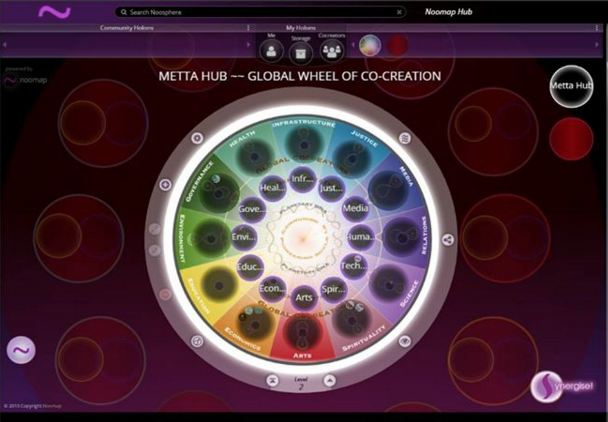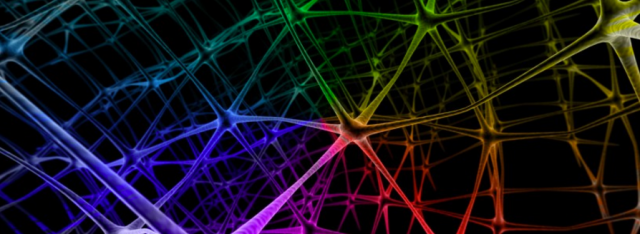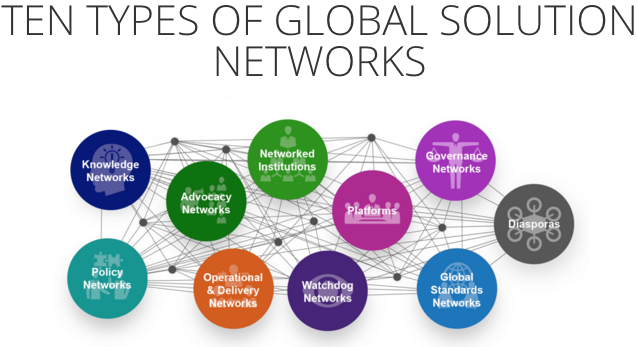This blog started as a reply to a post by a friend of mine on Facebook. Bret Warshawsky wrote:
“How about some love and co-creation? We’re beginning to map ‘Golden Innovations’ and need your help!
When you see a post or thread on FB, and share it, about ‘Projects already changing the system toward compassion, cooperation,sustainability and creativity.’ Please tag us with #noomaptheinnovations . We would really appreciate the support. The graphic in this screen grab is just a work in progress so more design to come.

Here’s my reply:
Bret, the interface is elegant and beautiful as always what you guys do. But that’s the easier part. The trickier is to design the pattern language for organizing the collected data and a smart information architecture that doesn’t only prevent the users from getting overloaded by the sheer volume and complexity of everything recorded, but also help them creating new hyper-trails of meaning. It’s something like that what I’m aiming for in a collaboration initiated by Christina Bowen, focused on “creating a map of org-structure, practices, and theory to show/ learn impacts on individual behavior and expression of collective intelligence,” which you can find in the #org-ecology channel of ResponsiveOrg on Slack .
Ours is only one of the MANY similar mapping efforts. The very fact that there’s a growing number of such efforts is a sign of our times, of discovering the urgency of what Barbara Marx Hubbard wrote:
“The awakening of our species and our search for solutions is occurring, but it’s scattered, and it’s certainly not in dominion anywhere. The larger social structures are proving to be inadequate to solve the problems they’re creating. New social innovations are emerging everywhere, but they are not sufficiently connected or empowered. So right now, any effort that we can make to connect and create greater synergy and participation in this awakening process is probably the most important thing we can do.”
I don’t remember when she wrote that but I quoted it first 10 years ago
here, and at numerous occasion since then, because it talks about a vital condition for our planetary evolution needs to carry itself forward.
In the ecosystem of global mapping efforts of transformational initiatives there are different species with different gifts to the whole. The one where I’m focusing my attention is not trying to catch everything that moves towards more compassion, cooperation, sustainability and creativity. There are zillions of such projects and previous mapping efforts that tried to portray them imploded under the very weight of the overwhelming richness and diversity of the landscape.
So my intention is to map a much smaller swath of the whole, only the initiatives aiming at reinventing organizations for supporting the well-being and evolution of all of their members and other stakeholders. Such initiatives are numbered “only” by the thousands which I find a more manageable number. 🙂
The infographic below is a first sketch for the landing face of such a map:
An ecosystem of movements for next-stage organization
I wrote a bit more about the map above in the
editorial of the September issue of Enlivening Edge.
The 4 characteristics of a GSN are: addresses a global problem; engages diverse stakeholders; exploits the digital revolution; and self-organizes and self-governs. GSN’s core ideas is that “enabled by the digital revolution, multi-stakeholder, self-governing networks are transforming how we solve global problems.The 10 types of networks pictured above are linked with issue-based hubs that span climate and planet stewardship, health and human security, employment and prosperity, and cities. On each hub expert curators invite nominations of successful GSNs to help grow a comprehensive network of GSN networks.
GSN claims to be the definitive resource of expert insights, cases and field tools for global problem solvers. Its funders are large institutions and to get listed you have to be proven successful at a global scale. Very different logic from how the bottom-up, grassroots networks organize themselves. It’s not better or worse than the latter ones, just addressing different audiences. If you’re a forward-thinking policy maker, go to and engage with GSN.
If you’re a movement catalyst, organizational change maker, or connector of people networks, and want to increase your effectiveness by connecting with the tip of the evolutionary wave, then go to and immerse yourself with the
Reinventing Organizations wiki and the community surrounding it. In that case, you may also want to pay attention to such new type self-managing and self-governing organizations as
Enspiral,
Metamaps,
Sensorica,
EdgeRyders and their brethren.
Technical folks from those groups are gathering, as we speak, and “scheming about what the fundamental technical aspects would be needed to enable a vastly more interoperable capability to our various web platforms.” Whether they will succeed or not is almost less important than the fact they
have engaged in co-creative relationships for growing something that can “act more so as an ecosystem of tools, than siloed off platforms” (
Connor Turland).
One of the questions that hold my attention, as I’m looking at their work, is what can the various projects of mapping “next-stage” organizational innovation learn from them? Can it be that facing challenges more complex than any group can successfully deal with inspires the recognition that when we meet things that are too complex to deal with, we need to ask for help from a larger collective intelligence? At some point in the development of our separate mapping projects we may recognize that there is no one method of mapping can do justice to the vastness of the tectonic shift between the dying old civilization and the emerging new.
At that point we’ll start turning towards each other, seeking interoperability. The sooner we reach that point the easier will be to have the maps talk with each other. Only then will their users, the people, communities, and organizations who need them, will have a more triple-E (more effective, efficient, and enjoyable) experience of navigating with them our turbulent, Emerging Planetary Reality.
Another important mapping effort was led by Rhonda Fabian and commissioned by Kosmos Journal:
Connecting for Change: Insights from an Emerging Global Transformation Movement
Based on research by the author, in collaboration with Jennifer Horner, PhD

“You might say it is the dark night of the planetary soul. Here we are in the midst of an ecological nightmare some are calling irreversible. The weight of war and human suffering seem overwhelming. We are bombarded with distress signals, but lulled by a media and political system that pushes distraction and more spending. Is it any wonder we try to evade our despair, that we close our eyes?
Yet at the same time, many people are waking up. They share a persistent inner sense that even the darkest night must be followed by a new day. Nearly every spiritual tradition says it is so and prophesizes a great planetary era still ahead and, though particulars differ, each asks for our faith that a better world is possible, predicated on peace and sharing. Science advances a similar, more immediate message: it’s now or never and cooperation is the key.
The Shift, Great Turning, and New Story are words used to describe what many are experiencing as a growing movement or awareness worldwide of the need to examine and restructure political, economic, and social systems to align more closely with the needs of humanity and the Earth.”
Kosmos Journal’s “Connecting for Change” study was one of the most substantive contributions to the field that I call “evolutionary cartography” that is focused on mapping the tip of the evolutionary wave of today’s epic transformations. Hopefully, the next phase of the study will receive the funding necessary to do justice to the complex tasks of mapping the fast-moving tip of the evolutionary transformations sweeping the world.
To be even more useful than Phase I was, Phase II of the study would need to organize and store its information, using a collaboratively developed “transformational movements” pattern language, maybe in a relational database at the back-end, and an engaging “advanced visual language”-based user interface as a publicly accessible front-end.
Coupled with social technologies (such as the U process, World Cafe, Appreciative Inquiry, etc.) baked in the software, Connecting for Change could become a fully self-organizing knowledge base and more — an engine of transformation, by connecting our conversations in the ecosystem, which i wrote about in Kosmos:
But it’s not only about software and information architecture, and maybe not even about them at the first place. Rhonda wrote earlier this year, “We are coming closer as a species to a new form of mental connection. It is possible to mentor, support, hold one another very deeply.” I replied: And it’s not only mental. For our species to awaken to its collective sentience, the global brain needs to be coupled with a global heart. That’s the focus of the paper that I am working on presently, “From Shared Mindfulness to Collective Intelligence to Collective Sentience.”
Since then, that paper was published and you can read it
here. It’s not hardcore futurism because the unscaled version of “collective sentience” is already present. Is is in caring for each other and this planet. Whatever mapping of the forces that work for a better world we develop, it should not be just an intellectual exercise. It needs to be guided by a desire to support all those to find a path to the future, who know that there must be an alternative to the status quo, and need to discover that not only they are not alone, but there’s a plethora of paths…






Hi George
There seems to be at least one important level missing from your map.
The work of David Snowden, on complexity, ways of thinking about and managing in different sorts of complexity, and channels of communication in complex environments is fascinating.
https://youtu.be/N7oz366X0-8 is a good introduction to his Cynefin framework and beyond.
I wrote blog post a couple of days ago in an AI context highlighting the much misunderstood role of cooperation in evolution and complexity more generally.
So we are strongly aligned in many contexts, and I seem to see things slightly differently.
Global cooperation, and evolution beyond scarcity based market values seems clearly and logically to be the next major step in human evolution, and there are issues at many levels around the systemic landscape of that emergence.
LikeLike
Ted, your comment reminded me that I should have made clearer what this blog is NOT about. My focus here is not various schools of thoughts, methods, and individual thinkers, but social movements with global reach. As mush as I respect the work of David Snowden, it lies outside the scope of the present blog.
LikeLike
Maybe it wont be outside scope for much longer 😉
LikeLike
Thank you, George, adding to my “ignorance” of all this fantastic activity. I’m impressed by your ability to follow it. I grok the exponential growth of relevant new knowledge in millions of new domains in the fractal array of emerging human potential. Is this evidence for the beginning of a movement towards synergy, or but another means of displaying our complexity? To me, these visual diagrams are a complex dance-floor/landscapes to new collective movement/dance. They aren’t treasure maps or guides to action.
What may be missing, in this effort to be fully comprehsive? I suggest: the need to uplift both our personal and collective distribution of competencies. Are we in a “state” waiting for the next shift to a new context? Newton, Darwin, Einstein contributed more than their theories, they triggered shifts in reality contexts, new epistemological/ontological assumptions. Today, few of our pioneers anticipate fundamental changes in themselves.
In my assessment, the emergence of new collective behavior requires complementary changes in the behavior/mentation of individual persons, and in a radical reassessment of the context within which persons/collectives do-their-thing (dance).
George, I am concerned that as many as we are, and as varied, we are all constrained by old perspectives/paradigms/barriers. Indeed, the very intensity and magnitude of our creativity may be blocking entry to new contexts. I am not saying that exploring a taxonomy of organizations and networks (attending carefully to their similarities and differences) isn’t essential. I speculate that they all are based on inaccurate and incomplete assumptions about the “nature” of humans and humankind, persons and collectives.
Unfortunately, I have no clear recommendations of how to proceed.
LikeLiked by 2 people
Larry Victor wrote:
> these visual diagrams are a complex dance-floor/landscapes to new collective movement/dance. They aren’t treasure maps or guides to action.
It’s an accurate assessment to which I’d only add that when they will be designed for an ensuing action-inquiry in mind, then they can become very seductive, inviting, engaging dance-floors or landscapes. At least that’s my aspirations, that’s what I’d like to attract partners to.
> the emergence of new collective behavior requires complementary changes in the behavior/mentation of individual persons, and in a radical reassessment of the context within which persons/collectives do-their-thing (dance).
Yet another essential perspective that Larry is consistently holding space for, in all of his writings. My take on that: none of us alone can complete those changes in our behavior/mentation, the radical reassessment of our context. That’s because there is no evolution, only co-evolution; we’re evolving with others, with the social field that we chose to be part of. Hence the importance of mapping emergence, which can help us making choices more suitable to our talents, highest aspirations, and grounded stage of development.
It is a special and precious form of that co-evolution what Rhon Fabian’s comment points to:
> The ‘new form of mental connection’ I mentioned has something to do with the deep neural grooves carved, in part, by sharing ‘a mental life’ with a counterpart through instant messaging technologies. Intuitively this feels like a higher order of symbolic negotiation – not without some serious shortcomings – and yet comes close to a kind of thought communication.
LikeLike
Beautiful work, George. Lest we forget that practical application is key. Real, applied experiments run by businesses and organizations alike (one of many reasons why I have been involved with startups). True connectivity – like language – happens when actions and outcomes are mapped together to procure ongoing learning patterns. This requires deep interpersonal communication, shadow work, and lots of conflict-driven breakthroughs with/from those who are often resistant to change. As a leader (a CEO), I see this everyday, and must work very hard on the way I conduct and navigate interactions; as well, I must be vigilantly self-responsible, particularly in the way I occur to others. Individual evolutions emanate outwardly, and the outcomes (many positive) show up quote quickly in group situations. These are acts of bravery and intense, rigorous discipline!
LikeLiked by 1 person
Thank you for mentioning the Kosmos Study, Connecting for Greater Impact and for including us in such good company. Your kind words mean so much. We hope to advance our research in two ways – through a wider study, which would require a more sophisticated coding scheme as you imply; and through a new community engagement and mapping project we are piloting now. I welcome the chance to discuss this.
The ‘new form of mental connection’ I mentioned has something to do with the deep neural grooves carved, in part, by sharing ‘a mental life’ with a counterpart through instant messaging technologies. Intuitively this feels like a higher order of symbolic negotiation – not without some serious shortcomings – and yet comes close to a kind of thought communication. I’m not much good at articulating this yet – although I have experienced it! I think it has metaphysical implications for collaboration, mentoring, and transformational group work.
LikeLiked by 1 person
Here’s a treasure chest of systems mapping tools by the amazing “evolutionary cartographer”, Kelvy Bird: http://www.kelvybird.com/system-mapping/
The eloquent maps (that absorb tremendous amount of complexity and express them with accessible simplicity) are opening the door to look at our reality in new ways.
Whether we walk through that door depends on our inner disposition to see things anew. If we do, and compare what we see, then we can propel our collective self to a new level of consciousness, intelligence, and wisdom.
That’s an exercise in all-quadrant development, which can be triggered by the kind of system mapping that Kelvy has mastered.
LikeLike
Wondering whether we can make any use of this open source mapping platform?
LikeLike